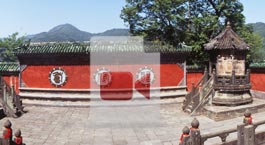General introduction to Wudang Taoism
Wudang Taoism came into being during the Song Dynasty (AD 420-479) and became popular across the country during the Ming (1368-1644), thanks to that dynasty’s 3rd Zhudi emperor.
To stabilize his regime, the emperor promoted the idea of the divine right of kings, saying that the god Zhenwu (whose shrine is on the mountain) protected him and supported Taoism.
In 1412, he sent a minister, Zhang Xin, and his son-in-law, Mu Xin, at the head of an army of 300,000 soldiers, civilians and craftsmen to Wudang for a large construction project. After 13 year period and a ton of money, they had produced 33 complexes on Wudang Mountain. After Zhudi, the emperors, nobility, local officials and followers continued to expand the temples and palaces on Wudang on a large scale.
The Ming Dynasty emperors were in charge of the Taoist rites directly and sent eunuchs and ministers to oversee things on the mountain. The royal family granted titles to the mountain, such as "Da Yue" and "Zhi Shi Xuan Yue", and respected it as the main family temple. Wudang Mountain occupied a prominent position among the four sacred national mountains and is known as the biggest site of royal Taoist rites.


